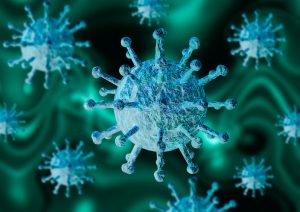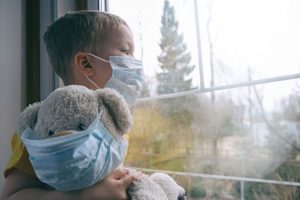When working with patients who have tested positive or are showing symptoms for SARS-CoV-2 (COVID-19), all healthcare professionals who are in direct contact with the patient should follow these infection control protocols:
- Minimize Possible Exposures – Separate possibly infectious patients from non-essential personnel.
- Follow Standard Precautions Throughout the Facility – Use basic personal precautions and protections:
- Hand Hygiene
- Appropriate PPE (respirator or facemask)
- Eye protection
- Gloves and Gowns
- Follow Special Precautions for Aerosol Generating Procedures – Additional PPE and the use of negative-pressure Airborne Infection Isolation Rooms (AIIR) should be considered for any procedures that could aerosolize body fluids.
- Regular Environmental Infection Control – All areas of the facility should be cleaned regularly with EPA-approved SARS-CoV-2 disinfectants.
Why is SARS-CoV-2 So Infectious?

SARS-CoV-2 has proven to be a particularly infectious disease for a number of different reasons:
- Transmissibility possible during asymptomatic periods
- High number of asymptomatic carriers
- ACE2 affinity and spike protein structure enhances binding properties
Early estimates of the R0 for the virus ranged between 1.4 and 7 before settling somewhere near the high end, between 5 and 6 according to an April analysis of data from Wuhan. Those numbers will vary according to cultural and precautionary steps being taken in different areas, but one thing is sure: it’s a much more contagious disease than the original SARS.
This has resulted in high rates of infection, and fatalities, among healthcare workers. As of April 15, the CDC reported 9,200 healthcare workers had been infected, with 27 cases resulting in death, in the United States. Overall, the agency expected healthcare workers alone to account for some 11% of total infections, which will raise those numbers far higher when the final accounting happens.
Currently, the primary mode of transmission is believed to be person-to-person, through respiratory droplets that contact the eyes, nose, or mouth, or get inhaled into the lungs. Surface transmission is also possible when droplets come to rest on a surface and are self-delivered to the eyes, nose, or mouth.
That warrants extra caution and careful compliance with an evolving set of infection control procedures.
How Can Nurses Minimize the Risks of Transmitting SARS-CoV-2 in Any Healthcare Setting?
Although SARS-CoV-2 gets top billing for being the big scary virus going around right now, it remains just a virus. Healthcare professionals have a deep library of engrained processes and procedures designed to minimize the spread of such bugs. None of the procedures currently recommended are novel or unfamiliar to nurses working today.
The major challenge today is in implementing those procedures at scale. As emergency departments and ICUs have filled to capacity, it becomes more challenging to follow basic precautions without additional preparation.
The basic steps for controlling infections in healthcare settings according to the CDC are:
Minimize Possible Exposures
Keeping likely and even possible cases from uninfected staff and other hospital visitors is an important first step. The fact that asymptomatic cases are so transmissible requires extra precautions.
- Establish Universal Source Control – The CDC recommends source control for everyone entering a healthcare facility today, regardless of symptoms, which means mandatory mask and hand sanitation at entryways. With supplies of medical-quality masks and respirators running low, visitors may be required to use cloth face coverings. Active screening for COVID-19 symptoms should occur at entry points.
- Reduce Points of Contact – Non-critical personnel should not be allowed near possible infected patients; staff who must be in the room with patients should take on additional tasks to reduce the total number of people who have to enter and exit.
- Establish Physical Engineering to Encourage Separation – The physical environment within the building should be configured to keep people separated as much as possible. Physical barriers between new arrivals and intake staff can be put up. Curtains and visible cues like floor markets for places to stand can help keep patients separated. Hospital air-handling systems may be configured to improve airflow and reduce recirculation in areas where infected patients are located.
Follow Standard Precautions Throughout the Facility
All the basic elements of infection control should continue to be vigilantly followed, before and after each shift and each patient contact:
- Hand Hygiene – Wash with soap or high-alcohol hand gel (60%-95%) before and after contact with patients, materials, or donning/doffing PPE.
- Respiratory protection – An N95 or higher filtration respirator, or face mask if respirators are unavailable, should be worn before entering patient care areas.
- Eye protection – Goggles or disposable face shield covering the front and sides should be worn in patient care areas and removed upon exiting.
- Gloves and Gowns – Disposable gloves and gown should be donned on entry to patient care areas and removed and disposed of after exiting. Spotters should be used for staff who are donning and doffing PPE to ensure appropriate technique and precautions are followed.
Consider Patient Placement
Patient placement should be considered both before and after diagnosis. Minimizing patient movement and contacts with staff and other, uninfected patients, can be accomplished by;
- Establishing isolation areas – Separate units and isolation areas should be designated for suspected and confirmed COVID-19 patients.
- Reducing hospitalization criteria – The goal should be keeping only medically necessary patients in the facility and allowing others to isolate at home.
Follow Special Precautions for Aerosol Generating Procedures
Additional PPE and the use of negative-pressure Airborne Infection Isolation Rooms (AIIR) should be considered for any procedures that could aerosolize body fluids. Alternate options, such as facemasks, are insufficient in this context. Respirators must be worn.
Regular Environmental Infection Control
All areas of the facility should be cleaned regularly with EPA-approved sanitizers.
- Dedicate Equipment – Equipment being used with COVID-19 patients which is not easily sanitized and in high demand should be restricted to treatment areas and used only with diagnosed patients.
- Laundry and waste services – Established laundry, food service, and medical waste procedures should be effective.
Monitor Healthcare Personnel
Since staff are at elevated risk of infection, that also makes them likely points of transmission. Although following the above procedures will help minimize the risk, regular monitoring of facility staff is recommended to catch possible infections early. The CDC suggests a temperature screen at the start of each shift, along with self-monitoring for other symptoms, and generous medical leave policies to encourage self-reporting.
What’s the Best Way to Handle Infection Control for SARS-CoV-2 in Overwhelmed Hospitals?

It’s easy to list the essential infection control procedures, but to implement them while providing adequate patient care with short-handed staffing requires additional planning and preparation:
Triage and Intake Considerations
With limited resources and high numbers of possible COVID-19 patients, triage becomes essential to manage and prioritize allocation and care.
- Prioritize PPE – Limited PPE supplies should be distributed with priority given to staff who will be in immediate and direct contact with confirmed infected patients.
- Patient screening – As much as possible, patients should be pre-screened without coming in contact with direct providers. While this can be done at intake by asking patients to call ahead, it can also be handled by asking arriving patients to call in from directly outside the facility before entering by posting phone numbers and instructions at entries. It can also be used after admission, by using phones in rooms to contact patients for a basic assessment before a provider is required to enter the room.
Improve Staff Efficiency
Workflow needs to be optimized to minimize not only exposure, but also movement. Simple aspects such as how supplies are stocked and where they are located can have a big impact on reducing virus spread. Minimizing the need to don and doff equipment reduces possible exposure points.
- Create taped-off “warm zones” outside patient rooms for dedicated donning/doffing areas
- Cohort patients with similar symptoms or vulnerabilities to reduce different precautionary procedures between patient contacts.
- Separate services by patient rather than by function to reduce the staff who have to enter a patient area. For instance, nurses may have to deliver meals or perform tech work rather than having other employees separately suit up and enter containment areas to perform a single function.
- Develop diagnostic or treatment protocols that do not require increasing exposure for staff; for example, Harborview Medical Center in Seattle figured out a way to shoot chest X-rays through doorways, keeping both X-ray techs and their equipment from having to be decontaminated after each visit.
Redesign Treatment Areas
Most facilities aren’t designed for constant, high level infection control protocols. Some basic redesign of how physical spaces are used can make infection control easier, such as:
- Align triage and treatment areas so patients can be transferred between them while minimizing exposure to other staff or areas.
- Consider how lab samples will be handled and transported; many hospitals have old vacuum tube systems that could create infection vectors when sending test swabs or other samples through the air ducts.
Cancel Elective Procedures
Many hospitals have already done this to clear the decks for COVID-19 patients, but it also reduces exposure to possible infections for non-essential personnel and staff.
Revisit Clinical Emergency Response Protocols
Standard crash protocols may not take into account higher standards of infection control required with COVID-19 patients. Review yours before patients start coding to ensure you can deliver appropriate resuscitation services without unnecessary exposures. You may also prioritize discussions of DNR status with COVID-19 patients or next of kin to eliminate unwarranted code calls.
Preparation
As much as possible should be accomplished before large numbers of cases are brought in. That includes:
- Training staff in infection control procedures.
- Taking inventory of PPE and other in-demand treatment equipment and attempting to increase available stocks.
- Pre-fit respirators and masks
Facilities should also broadly revisit their operations and current infection control procedures to determine what to take out during the COVID-19 response.
For example, existing hospital infection control processes that include more steps than would be useful under normal circumstances, such as contact tracing and testing, should be dropped according to CDC guidance. Most facilities don’t have access to sufficient numbers of tests, the additional staff to handle tracing, or the time necessary to go through this labor-intensive process.
Where Can You Find More Information About SARS-CoV-2 Infection Control?
One of the challenges in performing infection control for SARS-CoV-2 is that so there are still so many unknwns about the disease. Preprint studies are not as rigorous as the medical community typically requires for evidence-based care, and are sometimes conflicting or simply incorrect. For example, an early study which seemed to have found that the virus could be spread by aerosol at ranges of nearly 15 feet had serious implications for infection control procedures… but was later retracted.
That’s why it’s important to stay on top of new developments in infection control for the virus. The CDC maintains an interim guide for healthcare settings which it updates according to the latest available data. WHO also publishes a series of guides for specific scenarios and types of facilities handling COVID-19 patients.
There are also agencies that are dedicated to hospital infection control procedures and offer extensive resources backed by decades of experience. APIC, the Association for Professionals in Infection Control and Epidemiology, is providing free access to reference materials through at least September 30th. SHEA, the Society for Healthcare Epidemiology of America, also has a dedicated COVID-19 resource website.
Your facility should already have, or establish, an infection control team that can offer more specific guidance and keep it updated. The state of knowledge surrounding SARS-CoV-2 transmissibility is constantly evolving and best practices will change accordingly.






